When Ignatius, my hard-to-please shoulder gnome, says All Quiet in the Trenches “lacks teeth” I know he’s thinking about the gruesome sawtooth Seitengewehr 98 that we occasionally handled as youngsters. Why my father owned a WW1 ‘butchers blade’ I couldn’t tell you. Although interested in military history, he wasn’t a weapon collector. Maybe it had been bought cheap from some local bric-a-brac emporium. It certainly wasn’t an inherited souvenir. My great-grandfather didn’t bring anything back from the Western Front, not even himself.
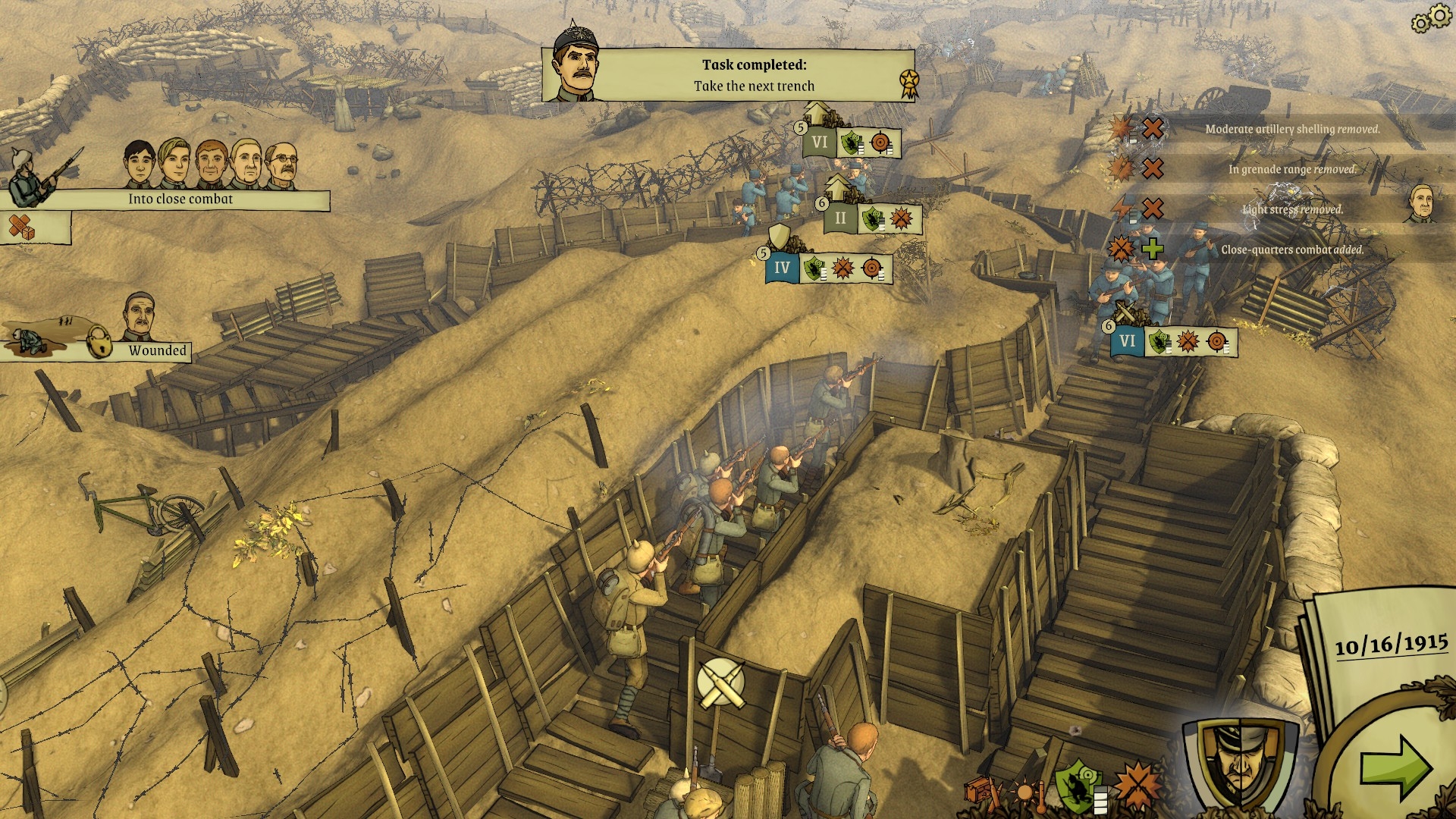
Ignatius has a point. AQITT is fresh, engrossing and – because of randomised squad compositions – even now, a couple of weeks into a two-year Early Access period, fairly replayable, but there is timidity at its heart that Erich Maria Remarque wouldn’t have approved of.
One of the reasons the 1929 novel referenced in the title of Totally Not Aliens’ debut was so distasteful to warmongers like Hitler, and still has the capacity to shock today, is that it pulls zero punches. All Quiet on the Western Front transports the reader into the man-made hell that was WWI trench warfare then forces them to gaze upon the myriad horrors found there.
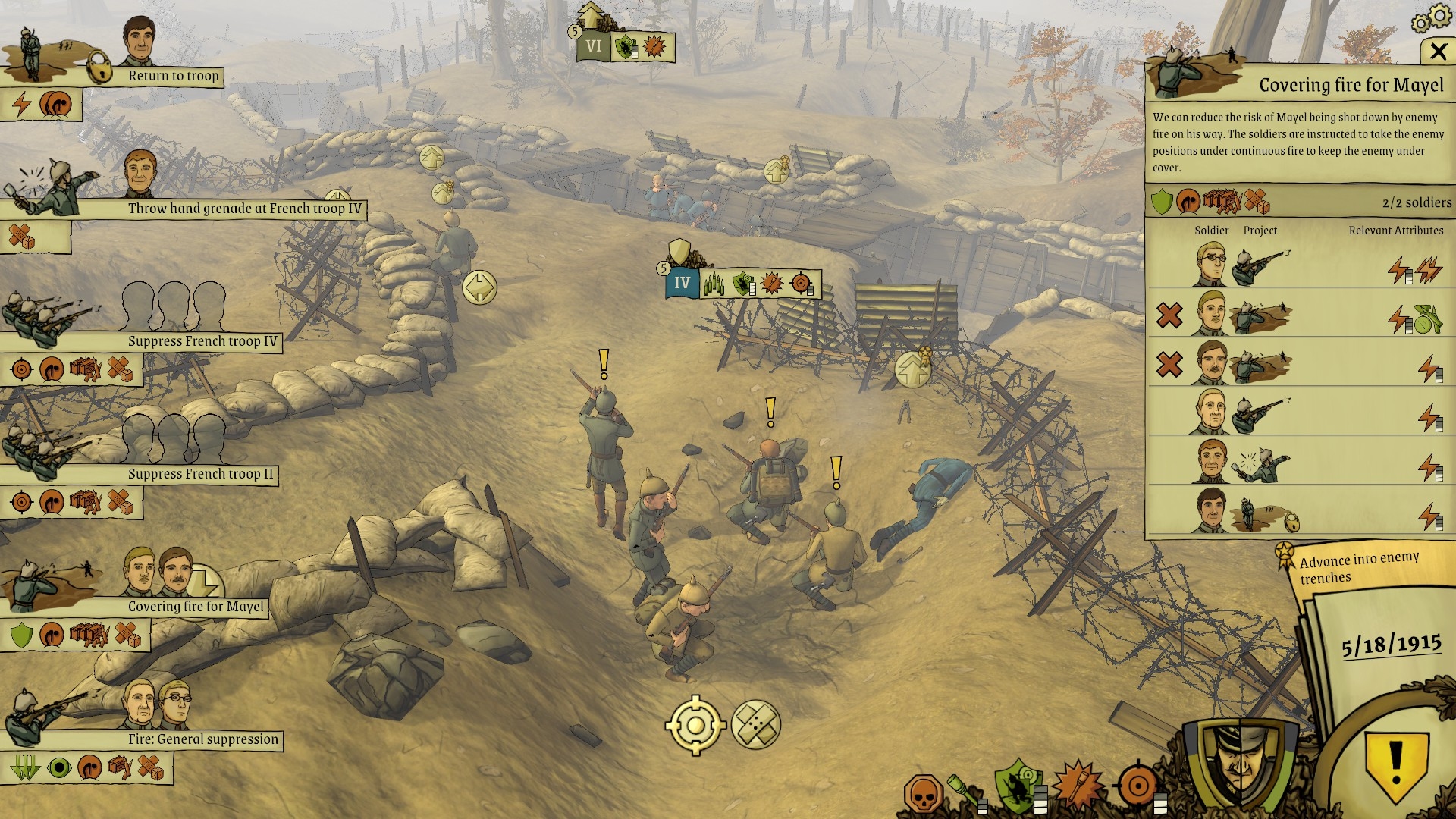
“Anti-war”AQITT, in contrast, makes for the same destination only to pussyfoot and veil on arrival. Yes, the individually taskable men in your squad can ‘suffer’ and ‘die’ during the course of a typical 3-4 hour playthrough*, but almost always the graphics, writing, and gameplay unwittingly conspire to make the suffering and deaths as palatable as possible.
* Currently the campaign only runs for one year.
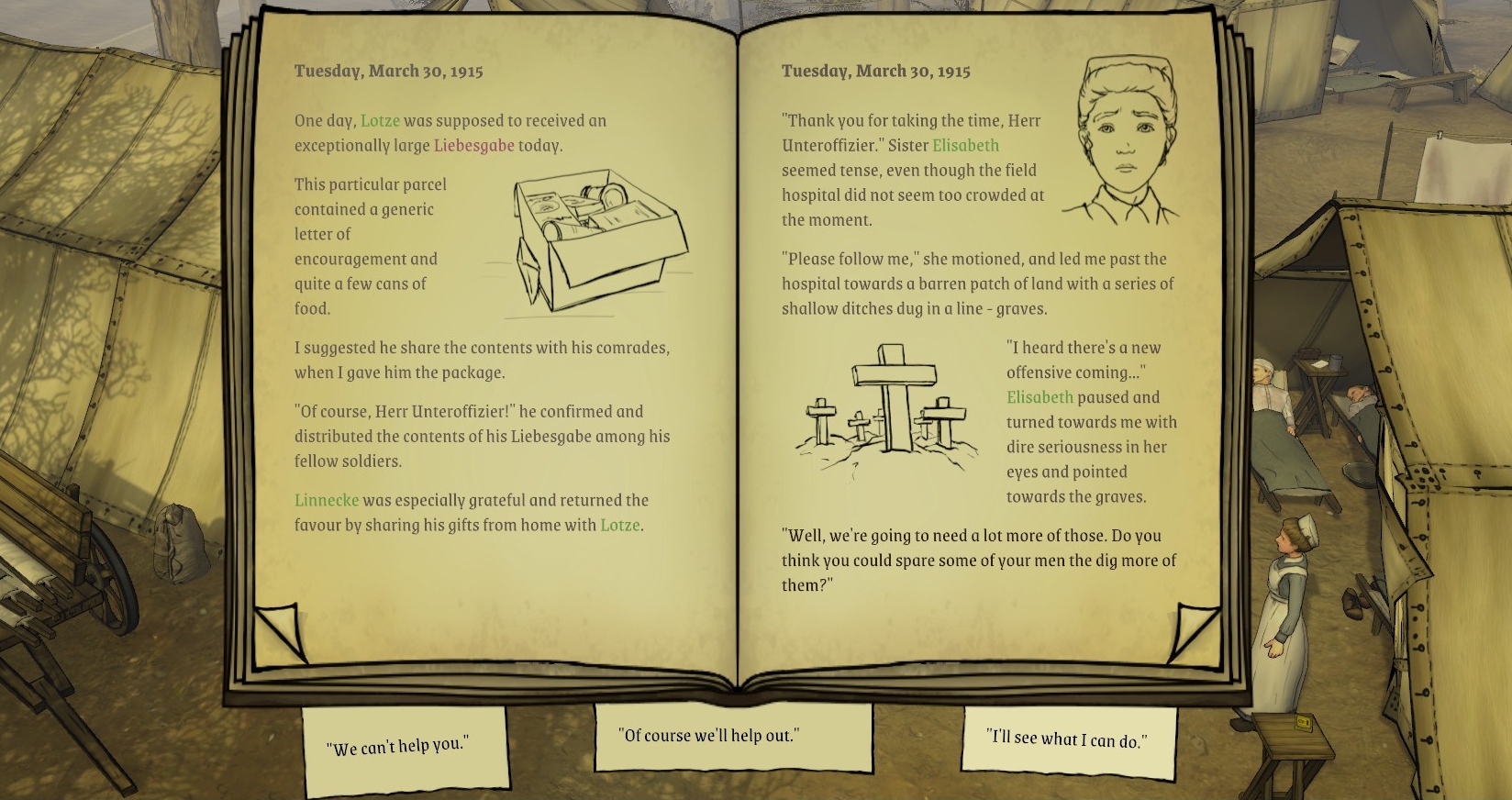
Playing this “narrative turn-based strategy RPG” don’t expect to encounter soldiers (all the following quotes are from AQOTWF) “without mouths, without jaws, without faces”… footless warriors staggering onwards on “splintered stumps”… people “living with their skulls blown open”. In AQITT no-one goes to a dressing station with hands clasped over bulging intestines, or holds “the artery of his arm in his teeth for two hours in order not to bleed to death”.
Rats scuttling across the faces of sleeping troops… maimed horses tripping over their own entrails… stretcher bearers so smashed by artillery “you could scrape them off the wall of the trench with a spoon and bury them in a mess-tin”… corpses in no man’s land that “hiss, belch, and make movements”… partially because the devs can’t bring themselves to document grotesque truths like these, we wind up with a game without the power to startle or appall.
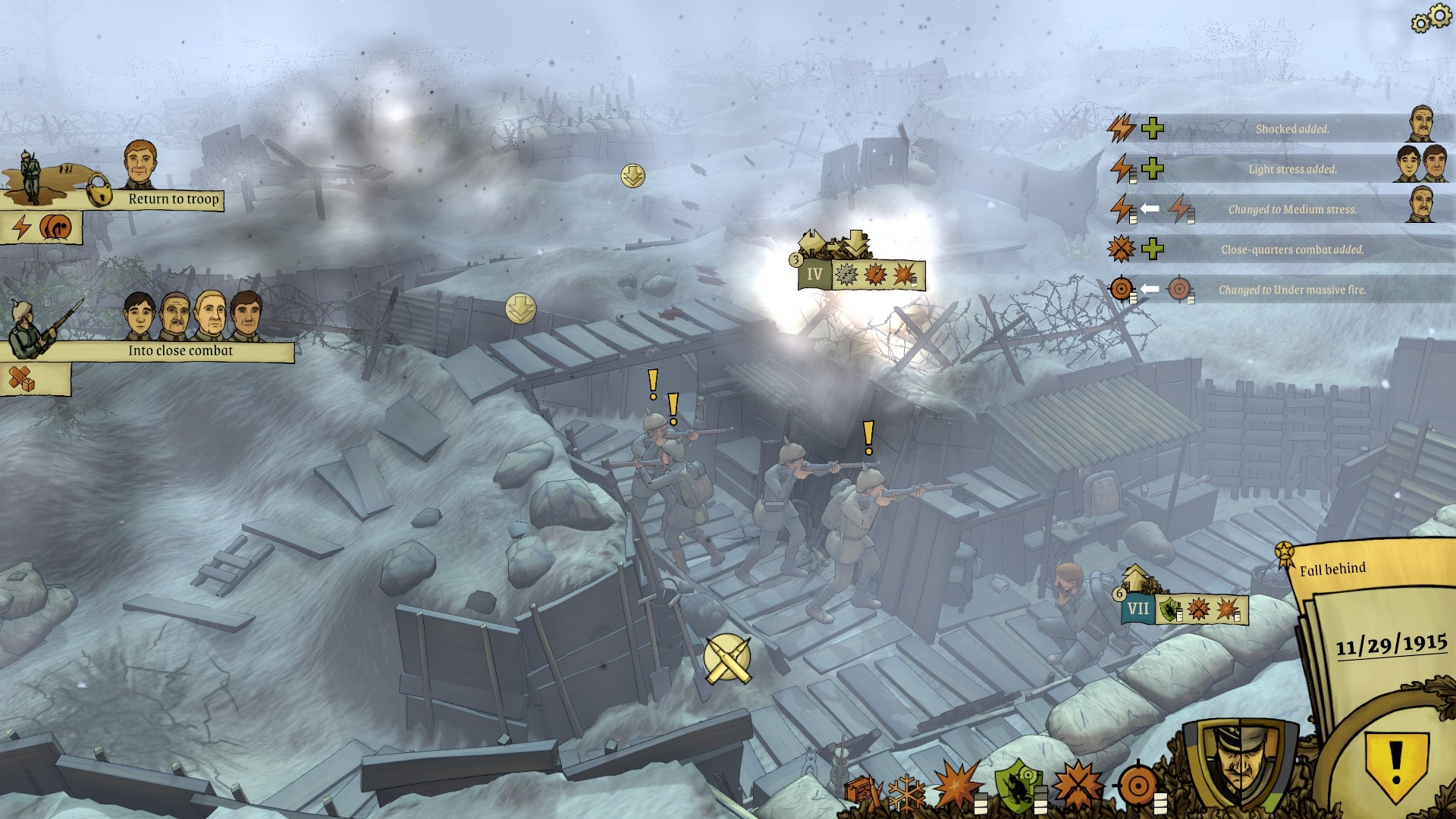
Neither me or Ignatius would deny that AQITT has the ability to excite and absorb, entertain and challenge. We both enjoyed our ten-hour playtest. The campaign’s combat phases went down particularly well.
Every thirty minutes or so your focus switches from juggling mundane daily chores in the front line or at a behind-the-lines camp to orchestrating offensive or defensive actions on 3D battlefields hiding networks of invisibly-linked, occupiable nodes.
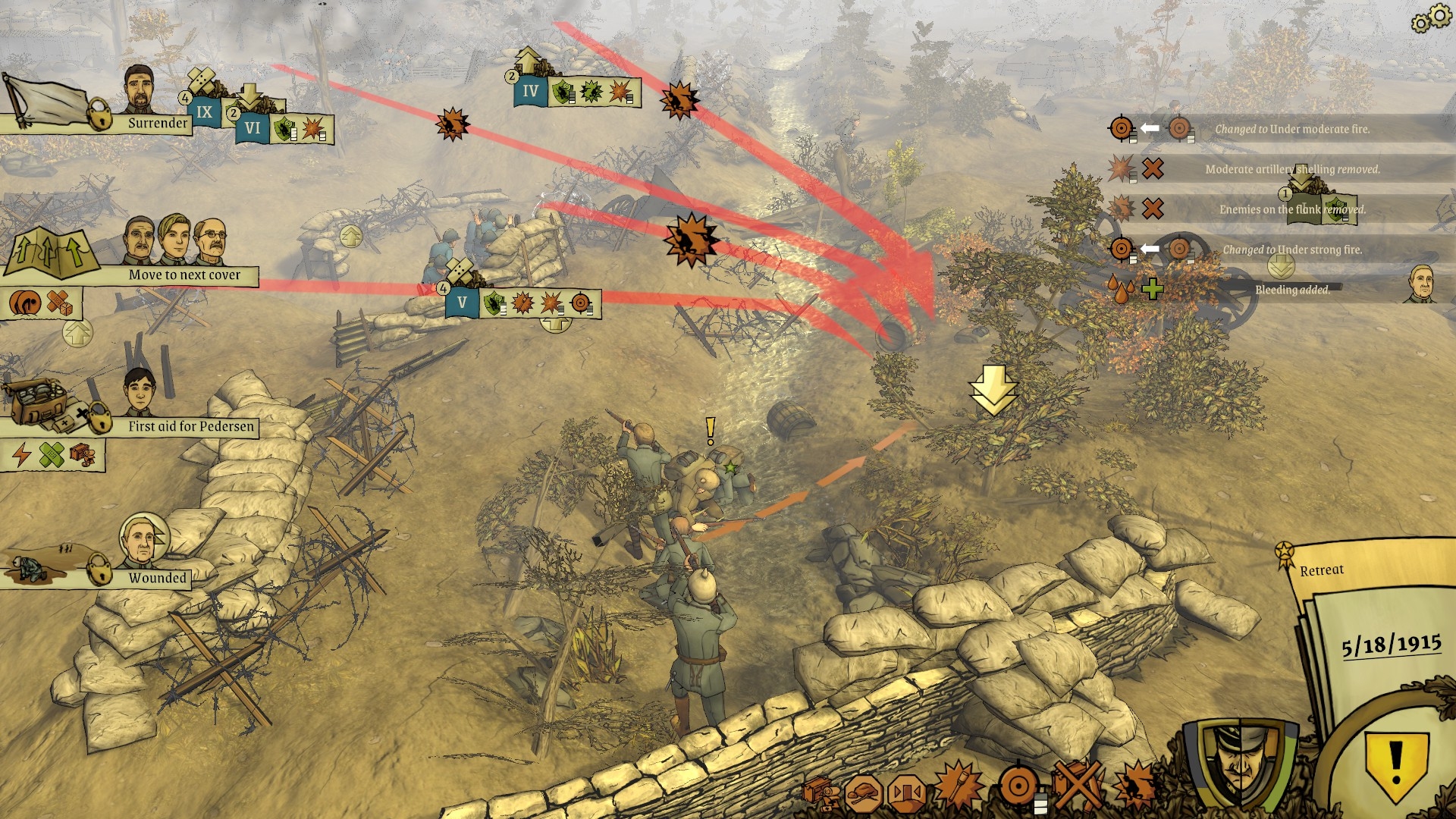
Send your men SW towards that corpse-strewn hollow and they’ll get the chance to scavenge for ammo and supplies, and deliver flanking fire next turn! Send them S to yonder crater and they’ll be in a slightly safer spot, but will need to do a bit of wire-cutting if the advance is to continue! Is now the time to switch everyone from ‘suppressing’ (one of the standard ways to employ troops during a scrap) to ‘taking cover’ (the safest and most restorative order option)? Can you afford to pause your retreat so that unlucky, immobilised Kummerbunt can receive first aid, or, with Frenchies closing in, should you just forget him and get all your able men to safety ASAP? The simple combatant assignment system meshes nicely with the hidden dice mechanics that determine things like enemy movement, fire results, and straggling (members of your squad can get separated and lost) producing a form of navigable chaos that wargamers partial to a bit of Clausewitzian friction are sure to relish.
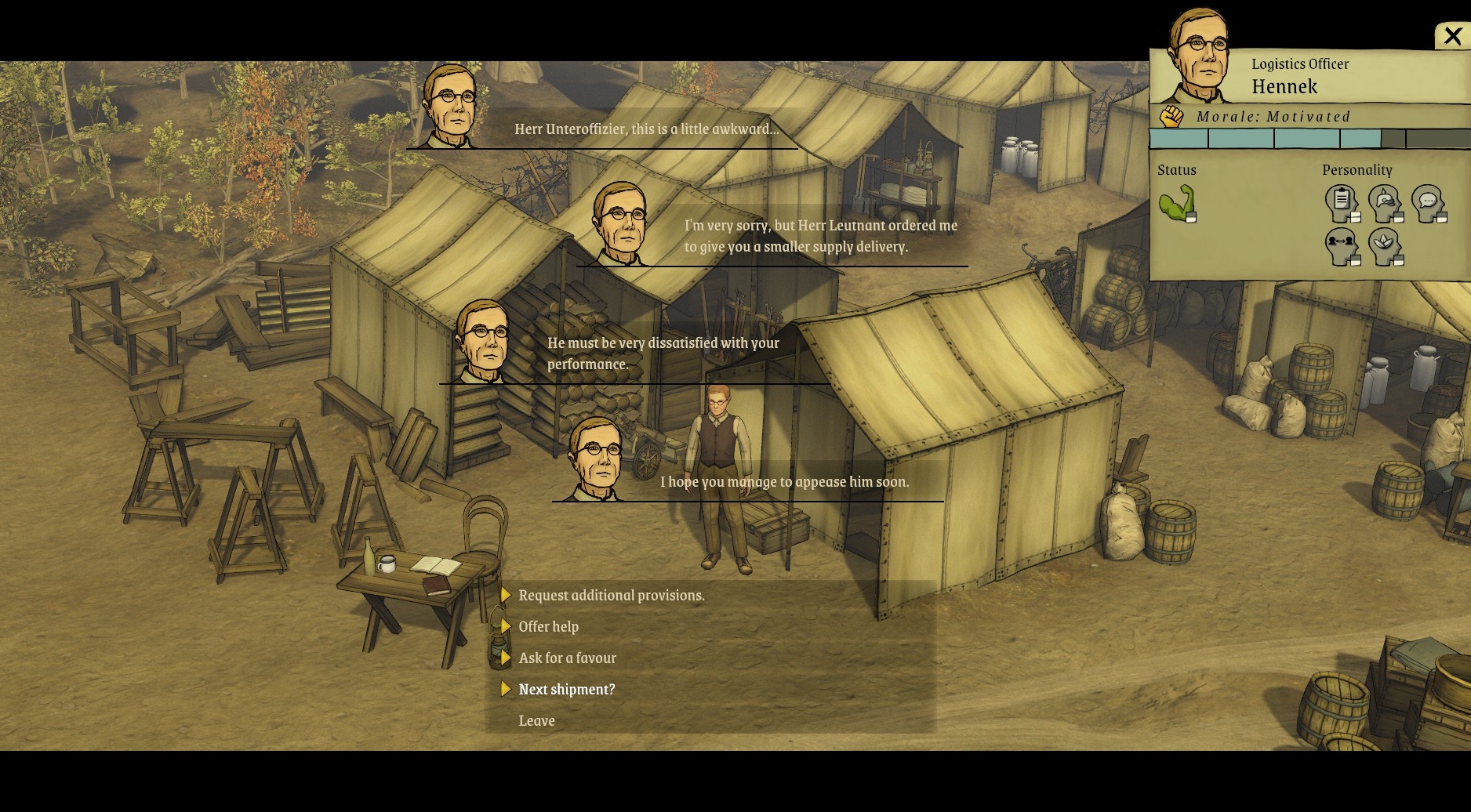
When you’re not trying to keep your band of Brüder alive and together on the battlefield, you’re generally trying to keep them happy, rested, and well fed in less lethal surroundings. Away from the front, the game is a thinly (perhaps too thinly at times) -disguised balancing act. Every turn there are camp chores and tasks set by your commander to be attended to. Neglecting the former can eventually lead to health and morale issues amongst your men. Neglecting the latter will aggravate your boss, a stickler prepared to demote you, effectively ending the game, if you disappoint him too often.
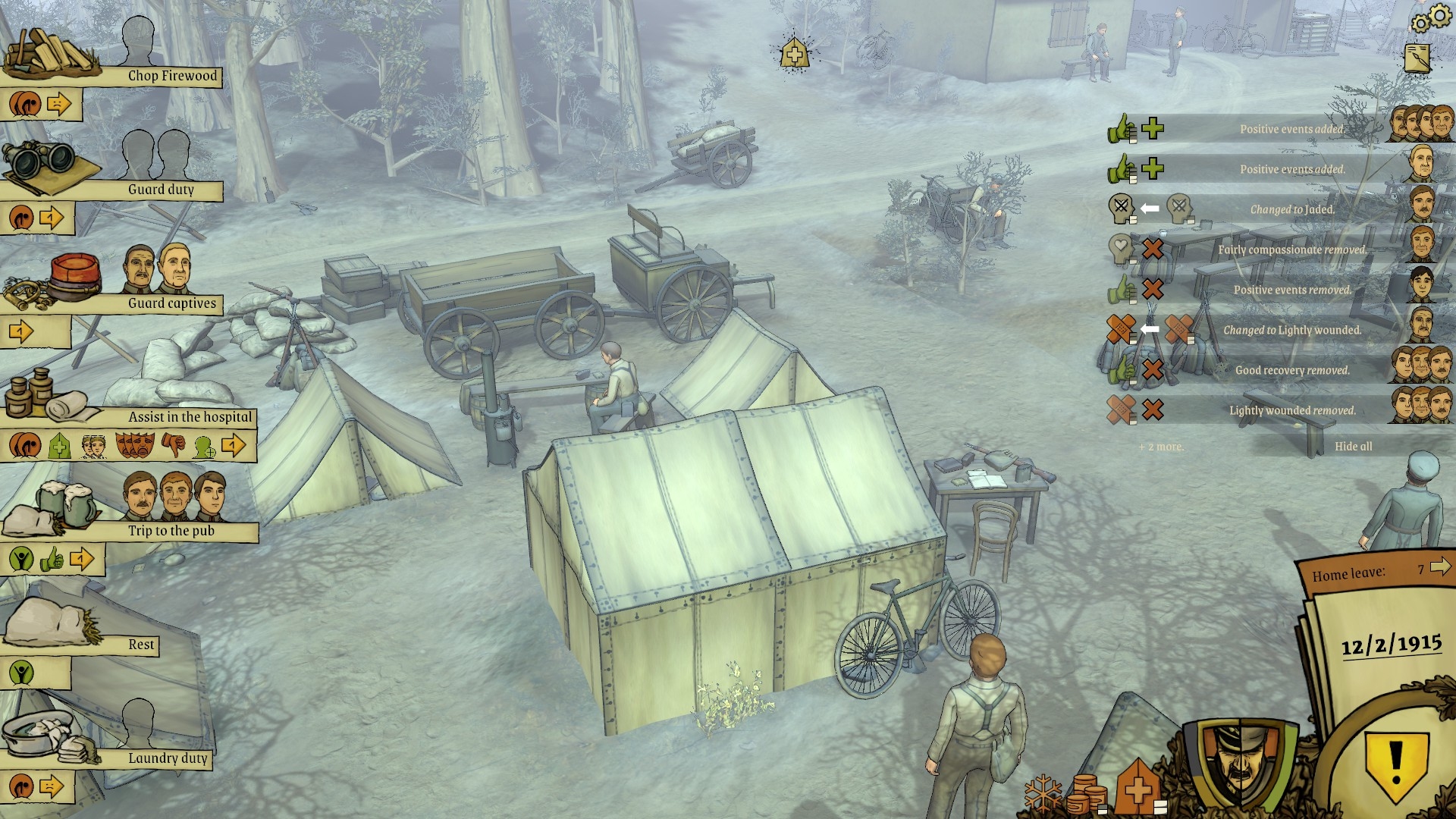
Picture the scene. Your squad arrives at the camp exhausted, dispirited, and probably denuded after a brutal spell at the front. What they really need is a few weeks of rest with the odd pub visit and slap-up feed thrown in. Instead, because you’ve got a Teutonic walrus breathing down your neck, and don’t fancy finding out what happens if latrines aren’t emptied and uniforms laundered regularly, you end up working them until they drop or are so incredibly unhappy they desert.
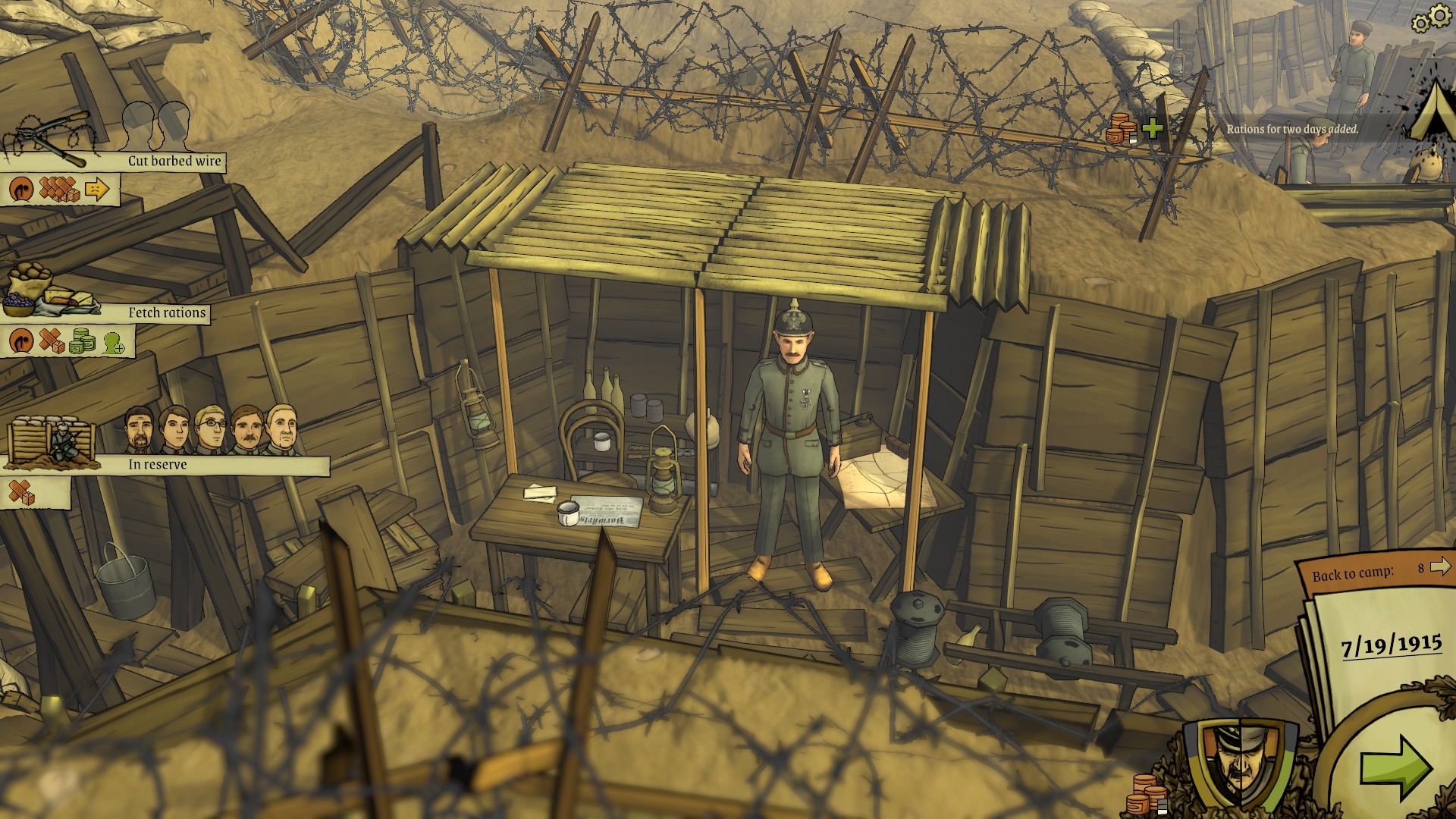
Finding the cigarette paper-thin line between under-utilising and over-utilising what are, in effect, your resources, is hard but possible. I was still an Unteroffizier at the end of my second playthrough, and a couple of the men I’d started the game with were still alive, which felt like a small win. Presently, because the game doesn’t do scores or even judgmental debriefs, you find yourself making your own victory conditions – no bad thing. For me and Ignatius, hearing that one of our MIAs had ended up in a French PoW camp was far more gratifying than learning that we’d helped repulse an enemy attack. I reckon that shows AQITT is getting something pretty fundamental right.
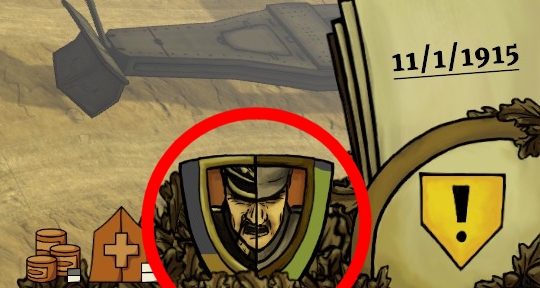
What would we change about the current EA build if we had the chance? For starters we’d redesign some of the unnecessarily confusing icons and UI meters. The worst offender is probably this ringed gizmo. It shows both the mood of your boss (left-hand bar) and the mood of your squad (right-hand bar), but does it in such an unintuitive way I still find myself mousing it regularly for clarification. You’d think, wouldn’t you, looking at the above, that I was in my commander’s bad book, yet the leader of a happy band, but no, actually everyone hated my guts when that jpeg was grabbed.
We’d also streamline some of the over-fussy camera transitions. We’re convinced AQITT would have worked equally well, perhaps better, with 2D graphics. Having to wait while the view swoops pointlessly between walrus, quartermaster, cook, and nurse at the start of every camp turn, only reinforces that conviction.
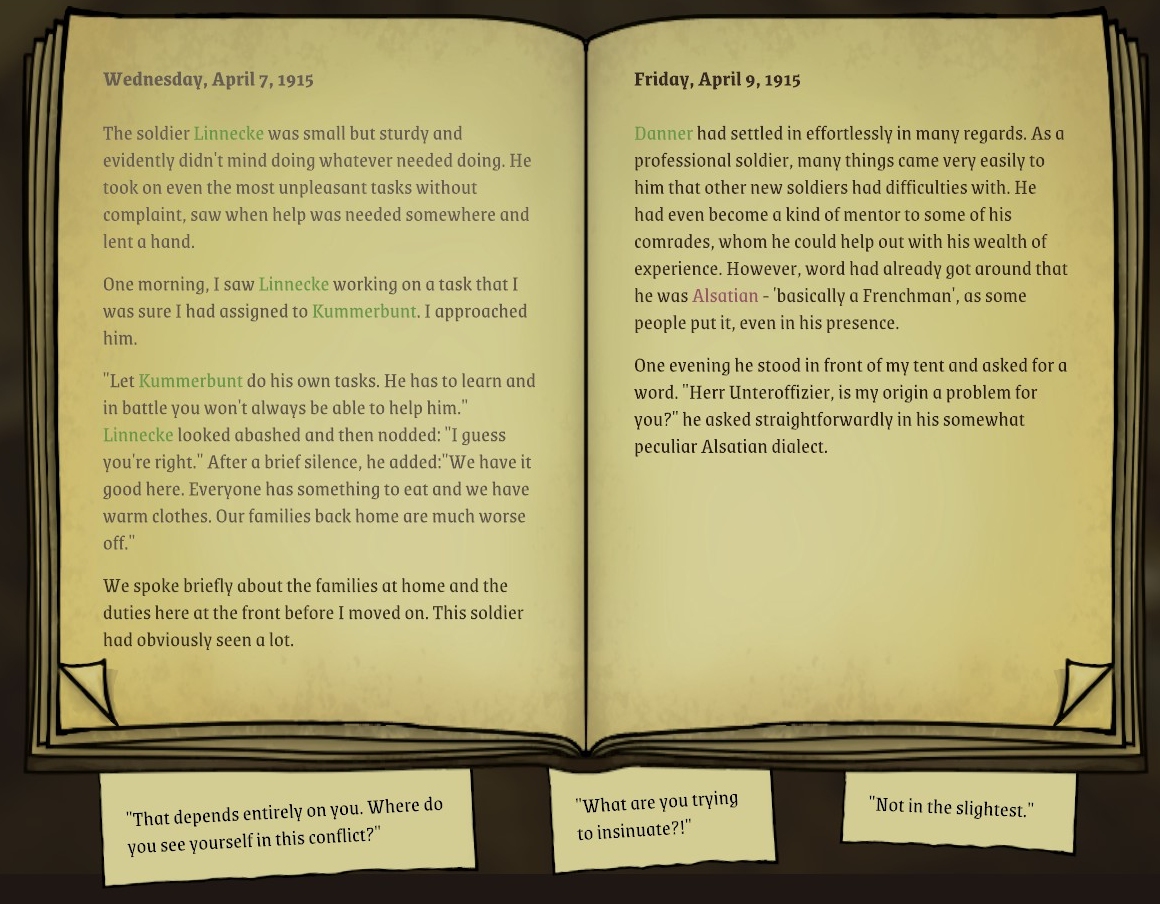
The game could really use some sharper writing or translation too. What’s provided is functional at best, jarringly clumsy at worst. Anyone familiar with AQITT’s literary touchstone* is unlikely to be impressed by the leaden language employed on the battlefield and in the IF passages in camp.
* AQOTWF isn’t just searingly honest, it’s beautifully written
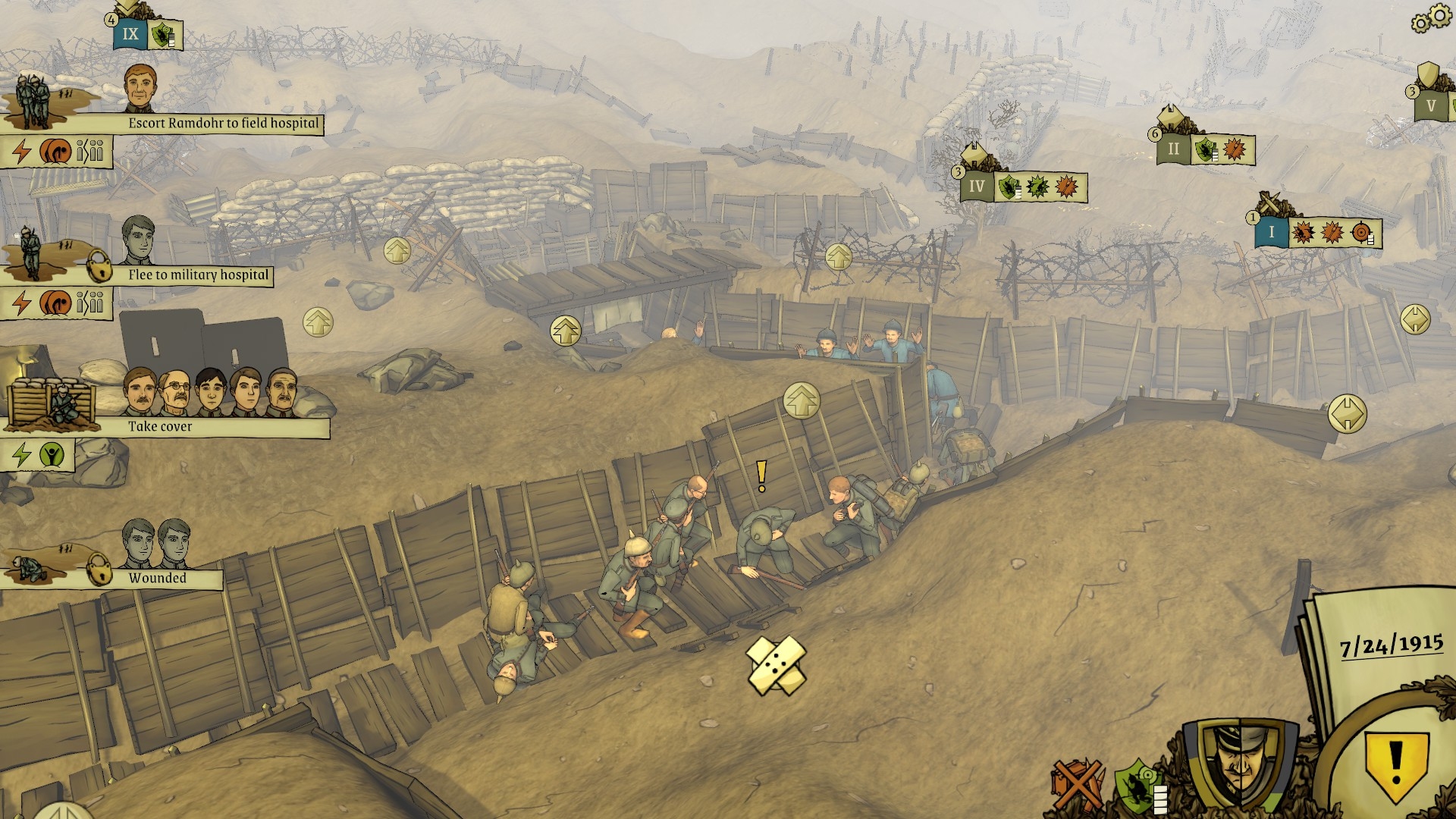
Judging by this roadmap (A lengthened campaign, MGs, gas, new soldiers and soldier traits are just a few of the coming improvements) Totally Not Aliens have no plans to introduce player avatars. Ignatius and I can’t understand this omission. By casting the player as a disembodied squad leader, a character that makes all the important decisions yet can’t be wounded/killed in battle or lead by example, the devs arguably miss a trick the size of the Lochnagar Crater.
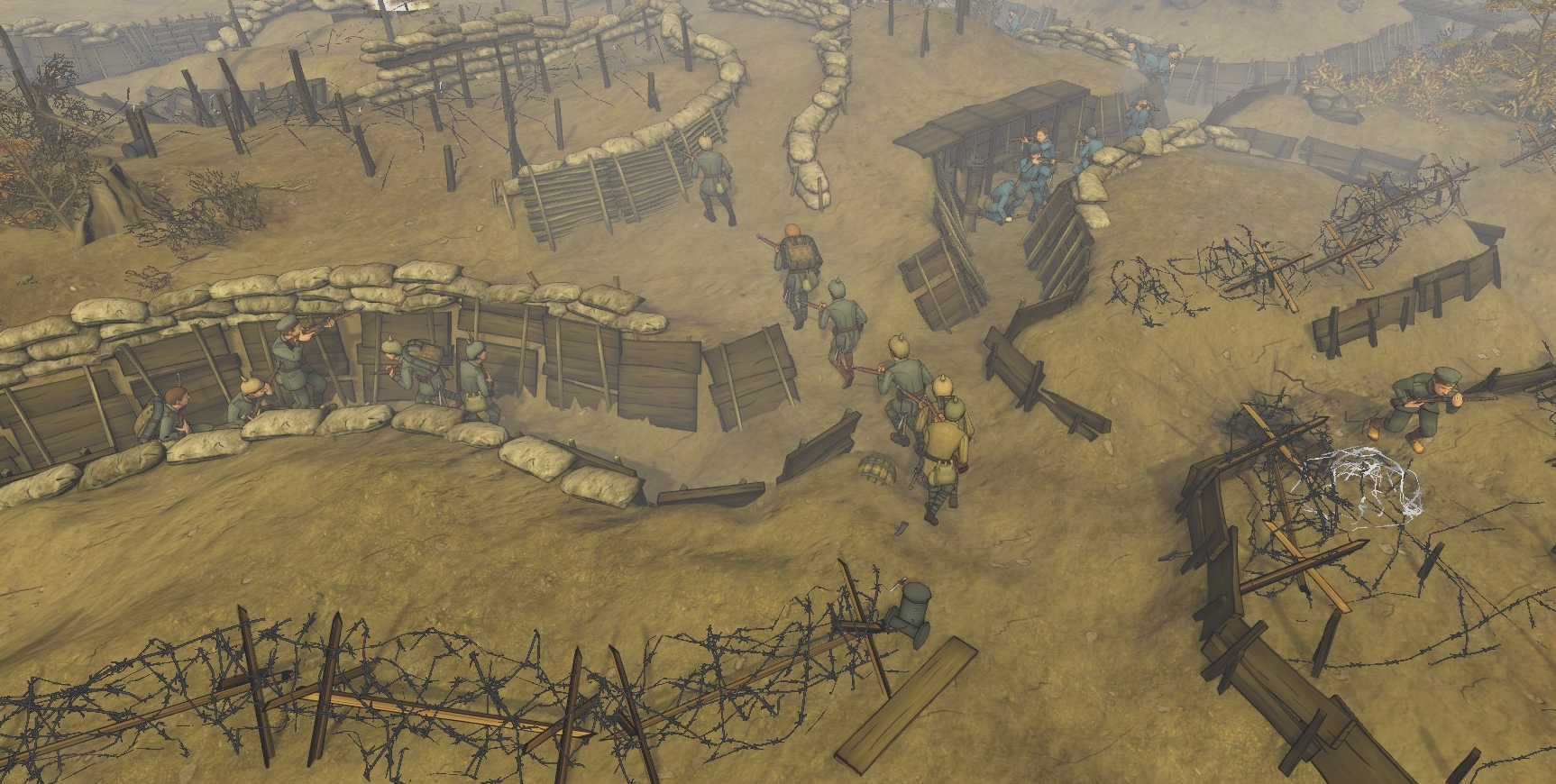
Timid, lacking in literary finesse, and featuring inexplicably incorporeal Unteroffiziers? Thank goodness All Quiet in the Trenches (£21) also happens to be strikingly different from the thousands of wargames that came before it, a dab-hand at serving-up tactical and HR dilemmas, and at the very start of its EA journey.

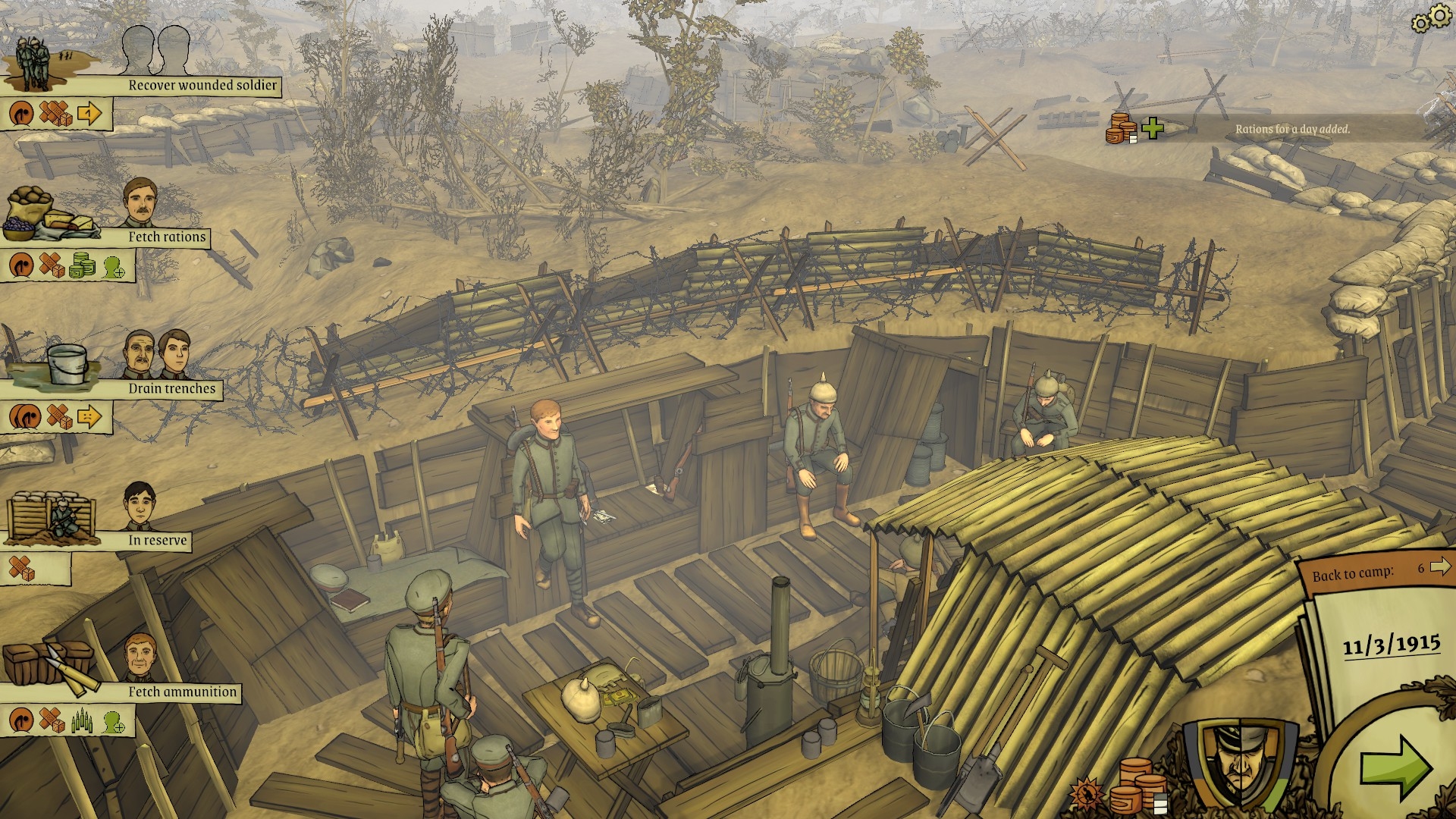
You know, I’ve been thinking for a long time now about how games often shy from portraying the horrors of historic and, let’s be honest, modern events. My first and primary reaction to this squeamishness was almost the same for a long time now. More so, failure to represent the horrors in interactive media often felt like it caused the narrative to flip from representation of reality to glorification or at least creation of romantic appeal for events that honestly have no buisness having such appeal.
But lately I have found a new perspective, that is not a perfect truth by itself but, I think, has enough value to be shared. My fresh idea is that the combination of gruesome reality and interactivity generates a weird space that makes problematic public behaviour possible and readily available for anyone. Just look at what YouTube creators tend to do with even lighter themes. While in vacuum I’d say that we’d do better to never forget and it is important to never sterilize our view of history and current reality, I also know that more than 75% of impressions from any piece of interactive media will come from people consuming derivative content like let’s plays. And then I see how creators induce themes of murder, slavery, kidnapping and so much more in such safe games like vanilla Sims, generating huge profits this way. Having seen this, I had to understand that interaction with true horrors in games would have been only effective if the only way to experience this was exclusively by personal interaction and wih intent to immerse yourself in the theme. But with how commercial media culture behaves itself nowadays, further accent on reality and horror are most likely to desensitize people even more towards the core themes.
Games often play with questionable themes, creating incentive to create content that exploits them for the wow factor, as they do themselves. Just surfing the titles of Rimworld videos or of recent Palworld content, it is clear to see that it would be very difficult to distance a brutally serious historical game from such perception. And theses are the safest examples. Just look at Ready or Not, where there are whole videos of people roleplaying abuse of hostages by police force without any kind of preventing measures from the game itself. How many viewers would say “no, this is not right” instead of “hell yeah, pepper spray her, she looks dumb”? I don’t even want to mention what tends to happen in AI powered games like Ai Dungeon, but I have to.
It is a weird thing, that there is such a problem and I feel even weirder advocating for self-censorship. However, I have to say, I think proper relation between the player/viewer and the reality of violence is achievable, but it is a very very difficult thing to do. One of the ways is to cut out the interactivity, but then we are better off reading a book or watching a movie, are we not? There are some games that try limited interactivity for the same purpose, but I have not yet seen a game that succeeded in doing this in believable way. There is also a factor of that this limited or lacking interactivity creates no interest for the content creators, so such games tend to be earning less PR points.
So that is it, I just wanted to share this important note that I have formulated recently on the topic. One can argue that we should not have sterilized games about real events at all then, but I, as a history buff and a wargamer, find hard to accept this view, at least purely emotionally. I know what happened. WHy should I suffer? And then I see some co-op streamers having “fun”, interacting with enemy NPC corpses and being racist/spewing out insane political takes in historical game in public and getting views for it and I have to say “okay, maybe we need to be careful about this, because this is too much”
And I forgot to mention, that historical games tend to represent real people, albeit in a generalised form, so there is more gravity to the impact of how gamers will treat these representations in public. Some people say that it is more of an issue when we represent events of recent history. This macabre “harmless fun” creates a social model that at its best makes the theme in question devoid of positive impact. So, yeah, as I’ve said, it seems that the more we lean into representation, the more we let mold this representation into a grotesque consumer good. And I wanted to highlight that I am not speaking about all this being possibly offensive to those that have some kind of relation to the events and the people that are represented this way. It is a completely separate point that needs a separate discussion.
I did have some notions of Interactivity being a Myth, but haven’t quite formed them into a reply.
If we’re being dystopian, then:
A) Accountability is Irony
Somewhat a buzzword of the moment, the news keeps telling us that too few people are being held accountable. When a game tries to claim to show a player the consequences of his/her actions, if it’s a small selection of actions to choose from (and the player wouldn’t wholly commit to just one as written) then it’s not really doing what it claims. I suspect most players just shrug it off; maybe they’ve seen such moves in other games and reckon it was intended as a gotcha or they’re the victim of some RNG.
B) The meta of games is teaching you to do what is asked of you
Games are not really about thinking. There is learning at the start, but that’s teaching you actions to perform _without_ thinking.
We’re getting into Milgram experiment / Skinner box territory. If a game tells people to go there and kill Person X, they’ll do it. They’ll do it all the more keenly for a sound cue of reward, a colourful skin for their weapon and 100XP.
They’ve Gameified the past – They’re Gameifying the present
(I should’ve made notes yesterday as I suspect I’ve forgotten some of what I meant to say. I’m afraid it’s still bullet-point-y)
Interactivity in Games is a Lie
1) This comments section has orders of magnitude more interactivity than games
Since what is posted will be read, hopefully digested, and then a considered reply will be returned.
2) This comments section still has orders less than face-to-face
As you can see the emotional weight a speaker gives their words; and a speaker expects non-verbal responses indicating comprehension.
(You can re-read paragraphs in books, and have a feeling where on the page to find them; you don’t quite get that in games, maybe RPGs with a conversation log)
3) It’s Choose Your Own Adventure rather than interactive
Your array of actions is decided by the programmer; and metrics for success/failure also. ‘Thinking outside the box’ solutions are likely to be exploits or cheats.
4) I have difficulty gauging the tone my inputs are going to be delivered in
A number of times I have chosen a phrase as I could imagine saying it sarcastically or as a bluff, and had a shock when it was played straight.
5) Interactivity with whom?
Tim’s screenshots show dialogue options with peers and subordinates. Obviously there’s a difference between management and command, but you don’t get the soft skills of attempting to get buy-in from your underlings. An option to be used occasionally to have your men decide between themselves might be interesting. Or, at the risk of making it even wordier, some sort of Disco Elysium-like vox pops from the troop.
6) It’s Plato’s Allegory of the Cave
2d people with 2d problems/solutions are always going to fall short in helping to understand 3d people in a 3d world.
7) Maybe this (AQITT) would work as Edu-tainment for GCSE History
8) Quote: “mold this representation into a grotesque consumer good”
I mostly concur and was going to write something similar before your reply, something along the lines of ‘gamefied content to be consumed and solved in a game-playing manner’.
So that I understand that I got your idea I’ll try to add an idea along the same lines. Please tell me if I am on the right track. Something like this:
“If interactive so called morals and horrors are transparently quantifiable, this interaction is more about rational and utilitarian expectations about future derivative entertainment more than about any real morals and horrors”.
And then maybe also something like:
“Ethics can only truly exist in context and never can be a subject of codification and algorithmization. Hence, most attempts at interactivity with such matters in a finite medium are, more or less, a caricature.”
Made me think about the absolute abomination of a game that will happen when someone will finally be able to cross-breed neural networks with procedural generation on a Dwarf Fortress scale. Disgusting. Can’t wait to play it
(I seem to know less than I thought I did earlier – Socrates would be pleased).
You’re ahead of me in thinking and articulating it being about ethics. I was being petty, and pseudo-philosophical, questioning whether it was actually a choice.
If the choices are A, B and C, and only A leads to a good result then deeper understanding will only come from explaining why – what is it about course of action A that should be rewarded, and B and C punished.
RPGs where the outcomes are shown pervert it even further: you pick the benefit you’d like at a price you’re willing to pay; the question/quandry becomes moot. (I’m not sure ‘utilitarian’ is quite the right word for this).
On the other hand, plenty of people seem content with games, and life, being black boxes: press button A, get output A. Society/parents are willing to punish miscreants/children who did action B and profess not to understand why it was wrong.
Since my brain’s had a bit more processing time I should make clear: Yes, players are making a choice… But, most likely, they’re not engaging at a level the writers hoped.
Take replayability.
If a game were a test of moral character then each playthrough would transpire pretty much the same since the player would make the same choices.
Runs of this game take 3 to 4 hours, so the inclination must be to try different options each time. To maintain that duration the upshot of each choice can’t shift the playing field too much; with very few exceptions you can’t win or lose in a single stroke.
Hence, every additional replay becomes even more an attempt at min-maxing: minimise the downsides, maximise the upsides, attempt to ‘win’ the game.
Damn, I cannot reply further down the hierarchy of the comments.
I wanted to mention an interesting exception, at least it is an exception for me. In Disco Elysium, that seems to be replayable and is all about philosophical conundrums, I just can’t force myself to play it again in any other manner than I played it the first time. My ongoing experiment about it is that I am going to wait a few years and try again, hopefully having achieved some changes in my own perception of reality and the questions it poses.
Having said that, it seems that this game succeeded, at least in my view, in creating questions and interactions (however limited in diversity) that work for me and do not feel like a subject to sober calculations at the same time.
I think I disagree on some points here.
Problematic public behaviour is very much possible and readily available, already. And I would argue that non-realistic, comicfied, overblown or cutesy depictions are equally or more enabling than realistic ones ever will.
You can always tell your yourself and your viewers, it is just a silly game, when you forced animals to fight to the death and eat the incestuous offspring of your eugenics program. With a realistic depiction of, say, a WWI gas attack, there is no such excuse. You cannot convincingly act like it is not horrible.
And, as you pointed out yourself, people do not need realistic interactive media to do the most unacceptable things in public. If you are set on it, you can do snuff movies with The Sims and Pokemon.
Giving people realistic games to behave horribly in will result in horrible scenes. But it is also more easily recognized for what it is in a realistic context.
The interactivity being a deciding factor is something I fear I do not understand. You can be just as terrible a person with non-interactive media. Showing footage from an active war theatre is not damnable (if properly labeled), but adding a lively soundtrack and a voice-over sneering and mocking the dying people is no less horredous than doing something similar in a game.
In a game conext the question is if the game prompts you to do such things and if it rewards you.
Also, we need to get more precise what we are talking about here. Not all horrors are treated equally. It is not just the violence that was mentioned (which gets depicted, in every imaginable and extreme way already), or cruelty (which is only insinuated or serves as an excuse for prompt righteous fury and cruel retribution) and finally misery. Which is often not treated at all. Maybe it could be given more space.
My first thought when looking at today´s review was how clean everything looked. How neat and easy to parse. Which is very far away from any realitstic WWI depiction.
I am not advocating for aiming to give every single one of your wargamer customers PTSD, because `that is what real war would do`. There is also no need to go to lenghts to make sure the player has every option to actively commit atrocities. But we could do with civilians and political factors playing a more prominent role in gaming. Or any at all. Or even just a proper chain of command, where you have to grapple with limitations instead of the typical care-free and and consequence-free enviroment many games make war look like.
Finally, I thiis is getting into the territory of talking about sandboxes or immersive sims and not wargames. Maybe this is what Colonel_K is touching on. Games have only X possible actions and Y listed goals. A full-blown immersive sim depicting real life will also share all of its horrors.
Good points!
Thanks, Gobser and Colonel_K. Interesting breakfast reading. The “exposing gamers to the true horrors of war leads to desensitisation” argument definitely deserves debate/study, especially if the games doing it allow the player to perpetrate those horrors. I regard AQITT as a bit of a special case though, because it relies so heavily on text to communicate detail, and because it knowingly evokes the unflinching AQOTWF with its title and premise.
I reckon the game’s IF core means there’s little danger of it becoming a toy for juvenile/tasteless YouTubers, and would have allowed the devs, if they’d wanted to, to communicate ghastly truths in a variety of ingenious/arresting ways. Obviously, if the player was wading through paragraphs of gruesome descriptions every few minutes there’d be a danger of desensitisation, but if the ‘horrors’ had been used sparingly and cleverly introduced, AQITT could, I think, have been far more powerful.
An example. Right now, during combat phases, you can send men to body-strewn spots to scavenge ammo and equipment. Exposure to the corpses in these spots impacts their morale which is great, but the ‘find texts’ generated by scavenging always take the same bald form (“We found some ammo” etc). If I was TNA, I’d have penned a dozen or so darker texts and displayed a random one every now and again just to remind the player of what the ‘Trumpton visuals’ (Iggy’s words!) weren’t showing.
Something similar could easily have been done with the hit/injury reports which, at present, are extremely mealy-mouthed.
Good points!
Interesting. I’m reminded of “Bomber Crew”, where the self-consciously cutesy portrayal didn’t help the game to my mind. There is a dearth of WWI games compared to many other periods.
Having read AQOTWF before a school trip to the French battlefields, I was marked down on some later written work for being ‘too gorey’ (sic).
Have you read Ernst Juenger’s “Storm of Steel”? Written (and perhaps published) before AQOTWF it provides another viewpoint as his personal experiences rather than a (semi) fictionalised novel, though it didn’t achieve the same position in the public consciousness. Also the source for a marvellous drink we call the Juenger Special, which is 1:1 red wine and Advocaat.
He’s a little like the completely bonkers Carton de Wiart (who “thoroughly enjoyed the war” despite losing many appendages), and he went on to embarrass Camus (who thought Juenger ought to have won the Nobel for literature instead of him) and wrote his Paris War Diaries about his time in WWII mainly spent collecting rare books and visiting salons.
I haven’t read Storm of Steel, but a requested library copy is now heading to my local bibliotek. Thanks for the recommendation.
Roman is currently reading Carton de Wiart’s Wikipedia page with great interest!
Alternative take on History-Ed.
Like an interactive museum exhibit I’d respect in middle age kludged to one I desired as an adolescent human-centipeded to an escape & evasion exercise, Aviators – War in the Skies is a free, erm, experience on Steam:
https://store.steampowered.com/app/2626910/Aviators/
Produced by Poland’s Institute of National Rememberance (approx. translation), you play as assorted Polish Air Force personnel in various stages of WW2.
It’s a 24GB download that takes 25GB of disk-space when installed. In a first for me, 6.5GB of that is green-screen videos for American Sign Language!
It was seemingly meant for controllers, but a recent patch makes keyboard and mouse usable. As is the way of things these days, on first launching the graphics settings were over-optimistic (a ludicrous resolution of 5000-something by 2000-something when I don’t have an ultrawide display, and every option at Ultra). Reducing it to 1920×1080 and everything on Medium gave acceptable performance (Radeon RX 5600XT) – I could probably have the textures on High as on Medium it was using 4GB of VRAM.
I needed to raise mouse sensitivity a lot to make it responsive in the menu and first missions, but then had to substantially reduce it for the last one.
The first level is the best, partly because the English voice acting is acceptable.
There was a game Tim lightly roasted a while back. I think it was mainly a WW2 flight sim, but you could spend some time on the ground cycling round a lovingly-recreated airfield for a Polish squadron; I never played it. This might be equally lifeless, but in even higher fidelity!
It’s contained within a hangar that houses a Halifax and 2 Spitfires. Follow the waypoints, interact with the indicated object and complete the mini-game/puzzle to move on. Pressing H gets you a so-called Hint, but frequently it’ll be the only clue to what you’re supposed to actually do. And a couple of times you have to mash the left mouse button rather than just pressing and holding.
Education is pretty much from reading the historical snippets that appear in what’s called the Journal. Some appear automatically as you progress, some in the stages where you can walk around you need to find and click on a poster/projector/photo/whatever.
Level 2 has you aboard a plane in flight.
Levels 3 to 5 have you in gunnery positions.
Assuming I can endure the download, there’s a good chance this will feature in the next 3×3!